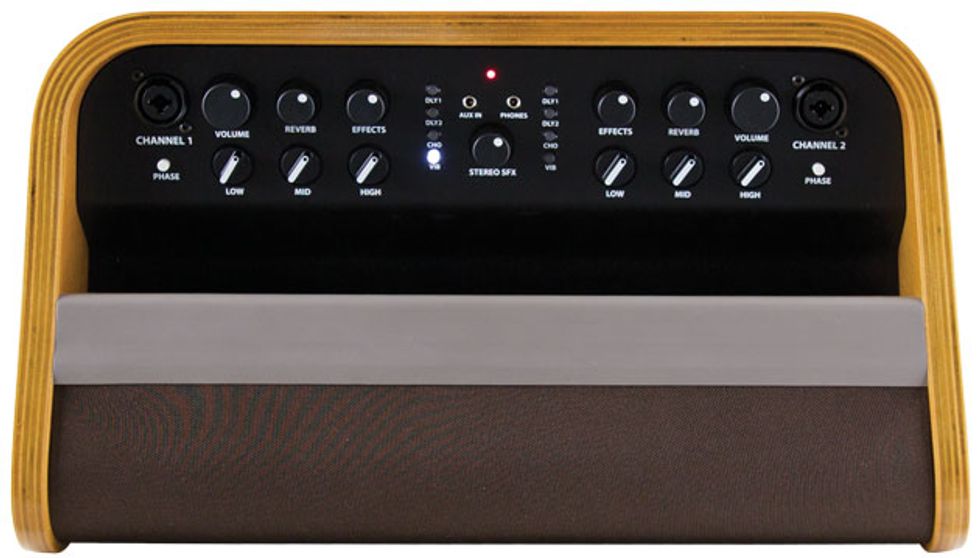 It’s easy to overlook the virtues of a good acoustic amplifier. Having one isn’t essential to enjoying your guitar at home or around a campfire. And any performance space with a microphone (or two, if you sing) and a PA will probably get your performance over to the crowd.
It’s easy to overlook the virtues of a good acoustic amplifier. Having one isn’t essential to enjoying your guitar at home or around a campfire. And any performance space with a microphone (or two, if you sing) and a PA will probably get your performance over to the crowd.
But if you’ve ever experienced the indignities of playing through a junk PA, you know that a little extra control over your performance situation is a very nice thing. And if you’re not willing to incur the inconvenience and expense of your own PA and DI, an acoustic amp is a good way to go.
Fender’s Acoustic SFX is a very good acoustic amp—rich sounding with a functional stereo speaker array and a selection of effects that make it sound downright expansive at times. But it also manages the neat trick of being a sort of all-in-one acoustic performance “mothership” without being bogged down by bells, whistles, and sound optimization tools that are tricky to use on the fly.
Sonic Redistribution The Acoustic SFX is not Fender’s first acoustic amp to feature the SFX (stereo field expansion) technology. Two previous iterations of the Acoustasonic line featured the stereo sound distribution technique devised by Aspen Pittman and Drew Daniels. In brief, the SFX system is based on a forward-facing speaker and a second, smaller speaker that’s situated below and at 90 degrees from the forward-facing driver. The front-facing speaker receives and broadcasts the sum of left and right signals. The second, smaller speaker receives a left-minus-right signal. While the speakers are technically rendered out of phase, what you hear is not thin phase cancellation but a wider signal that’s divided into component parts and redistributed in a wave of sound that arrives at the ear as a more detailed sonic picture.
Fender incorporated the SFX speaker array into the cabinet design beautifully—creating small portholes on either side of the amp and a rectangular port on the rear. Thoughtful design abounds elsewhere. The entire topside of the amp just forward of the control panel is a very confortable, contoured handle. The cavity between the handle and the control panel functions as a cool little stash box where you can put slides, picks, or whatever device you might be using for backing tracks or between-set tunes. The curved 9-ply wood cabinet, meanwhile, looks like it was lifted from an Eames chair.
 The control set is a straightforward affair that’s pretty easy to navigate. There’s a single volume knob, a three-band EQ, and reverb and effects-level controls for each of the amplifier’s channels. Each channel has a phase button if you run into trouble with feedback. The third, middle set of controls is for the amp’s effects and the SFX functionality, which, as we’ll see, enhances the sound of the amp in profound ways. The effects set includes a simple one-repeat delay, a multi-repeat delay, chorus, and vibrato. Each is tap-tempo enabled and can be bypassed via an optional footswitch or by turning the effects knob to zero.
The control set is a straightforward affair that’s pretty easy to navigate. There’s a single volume knob, a three-band EQ, and reverb and effects-level controls for each of the amplifier’s channels. Each channel has a phase button if you run into trouble with feedback. The third, middle set of controls is for the amp’s effects and the SFX functionality, which, as we’ll see, enhances the sound of the amp in profound ways. The effects set includes a simple one-repeat delay, a multi-repeat delay, chorus, and vibrato. Each is tap-tempo enabled and can be bypassed via an optional footswitch or by turning the effects knob to zero.
The SFX knob is essentially a level/balance control that determines how much sound is distributed to the side-mounted speaker. But its character shifts considerably depending on how you set the effects and at what level.
The back panel has a pretty standard set of acoustic amp I/Os (balanced XLR out, combination XLR/1/4" mic/line inputs), a voltage selector, and a footswitch jack for remotely bypassing the effects.
Street:
$899
Fender Acoustic SFX fender.com
Acoustic Architecture in Practice In it’s most straightforward setup and at the lowest possible SFX settings, the Acoustic SFX is a great blank slate for most acoustics. I used a mahogany Martin 00-15 and Gibson J-45 with L.R. Baggs Element pickups. And while the amp seemed to favor the Gibson’s balance of low end and patina’d highs to the Martin’s more compact, sparklier personality, the EQ controls provided ample headroom to dial up very pretty approximations of each guitar’s voice.
Dialing in the SFX function pays big dividends, though, and I often wondered why one would ever opt to dial out the function entirely. While Fender makes much of the way the SFX design works with the reverb and effects to add extra dimension, I was equally—if not more—impressed with how high levels of the second speaker added headroom and flexibility to the EQ controls, which are typically the hardest thing to dial in right on an acoustic amp.
At high stereo SFX settings, the amp’s intrinsic high-end sensitivity was more apparent, but so was an extra bit of presence and air that made the high end of both guitars sound less boxy. Dialing in a high/mid setting that eliminated crispy, clacky picking artifacts without totally diminishing the sparkling overtones was relatively effortless. And bass sounds took on a warmer, more atmospheric edge that enabled me to reduce the already ample bass response. If you move between performance spaces of varying size, the added headroom and dimension the SFX function adds to the EQ controls can be invaluable. And if you use a lot of low-tuned alternate tunings, that extra dimension and enhanced frequency balance can enliven overtones in beautiful ways.
The effects, while not spectacularly rich, deep, or colorful, work well with the amp’s basic voice. The reverb, in particular, is quite nice at mellower settings. I especially enjoyed mixing it in with a little of the multi-repeat delay for atmospheric chord arpeggios. If you like things especially spacy, the Acoustic SFX effects will go there, although they sound less warm at higher levels.
The Verdict There’s much to like about the Acoustic SFX. It’s stylish, functional, and delivers ease-of-use and true sound-sculpting potential at a price that’s still well south of many other professional grade acoustic amps. There’s room for improvement here and there: The high midrange could be a little softer and more contoured, for instance. But the ample headroom and cool SFX-derived sounds make this amp a very solid and reliable gigging partner.
